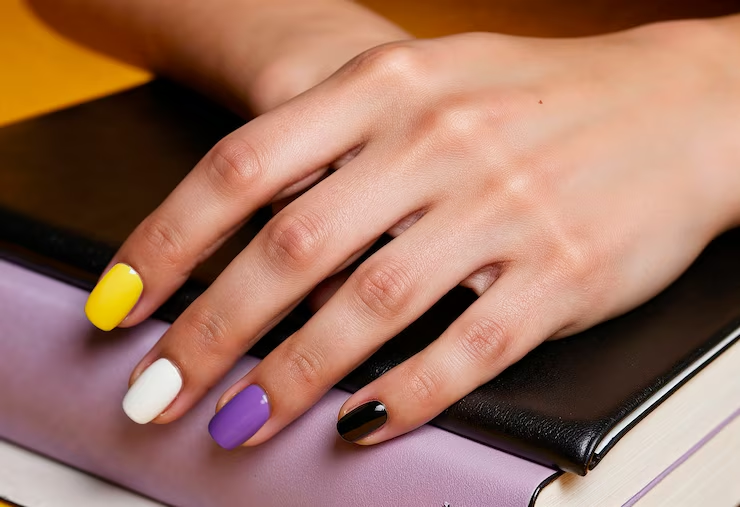How to Remove Dip Nails at Home
Are your dip nails growing out, or are you ready for a fresh look? Learning how to remove dip nails at home safely can save time and money while protecting your natural nails. This comprehensive guide walks through everything needed for successful DIY dip nail removal.
Key Takeaways:
- The foil and acetone method is most effective with a 95% success rate
- Proper removal takes 15-25 minutes on average
- Never peel or force off dip powder
- Aftercare is crucial for nail health
- Professional help may be needed for difficult cases

Understanding Dip Nails
What Are Dip Nails?
Dip nails use a powder-based system where nails are dipped into colored powder and sealed with a protective coating. Unlike gel or acrylic nails, dip powder creates a lighter yet durable finish that can last up to four weeks .
Why Remove Dip Nails at Home?
Common reasons include:
- Natural nail growth
- Desire for a color change
- Cost savings
- Convenience of at-home removal
- Addressing nail health concerns
Essential Tools and Supplies
Must-Have Items
- 100% pure acetone
- Cotton balls or pads
- Aluminum foil
- Medium-grit nail file
- Cuticle pusher or orangewood stick
- Nail buffer
- Cuticle oil
- Hand moisturizer
Optional Tools
- Soak-off bowls
- Plastic bags for alternative methods
- Warm towels
- Nail clips instead of foil
Preparing for Safe Removal
Setting Up Your Workspace
- Choose a well-ventilated area
- Protect surfaces from acetone spills
- Remove jewelry
- Gather all supplies before starting
Pre-Removal Assessment
- Check nail length and trim if needed
- Examine nail health
- Push back cuticles gently
- Remove any loose powder or top coat
Step-by-Step Removal Methods
Method 1: Foil and Acetone Soak (Most Recommended)
This method shows the highest success rate at 95% :
- File the shiny top coat gently
- Soak cotton in pure acetone
- Place soaked cotton on nails
- Wrap each finger in foil
- Wait 15-20 minutes
- Remove foil and gently push off softened powder
Method 2: Baggie Soak Method
With a 90% success rate and shorter average time:
- Fill a plastic bag with acetone
- Insert fingers
- Massage nails through the bag
- Soak for 10-15 minutes
- Remove and gently scrape off powder
Method 3: Filing Method (Not Recommended)
This method shows only a 60% success rate and higher risk of damage:
- File down powder layers
- Buff remaining residue
- Apply cuticle oil frequently

Common Mistakes to Avoid
Never Do These
- Peeling or picking at dip powder
- Using non-acetone removers
- Forcing removal when powder hasn’t softened
- Skipping aftercare
Warning Signs
- Pain or discomfort
- Bleeding or nail separation
- White spots or discoloration
- Unusual texture changes
Aftercare and Nail Recovery
Immediate Care
- Wash hands thoroughly
- Apply cuticle oil
- Use nail strengthener
- Moisturize hands and nails
Long-Term Care
- Give nails a 1-2 week break between applications
- Use nourishing treatments daily
- Monitor for signs of damage
- Consider supplements for nail health
When to Seek Professional Help
Red Flags
- Severe nail damage
- Signs of infection
- Extremely thick or stubborn dip powder
- Previous removal attempts failed
Professional Benefits
- Proper tools and techniques
- Experienced handling of complications
- Minimal risk of damage
- Expert nail health assessment
Frequently Asked Questions
Q: How often can I safely remove and reapply dip nails? A: Wait 1-2 weeks between applications to maintain nail health .
Q: Can I use regular nail polish remover? A: No, only 100% pure acetone effectively dissolves dip powder .
Q: What if my nails won’t come off easily? A: Never force removal. Resoak in acetone or seek professional help .
Conclusion
Removing dip nails at home requires patience, proper tools, and gentle techniques. The foil and acetone method proves most effective, while filing alone risks nail damage. Remember to prioritize nail health and never force removal if experiencing difficulties.

For more, visit our website Home Threads







